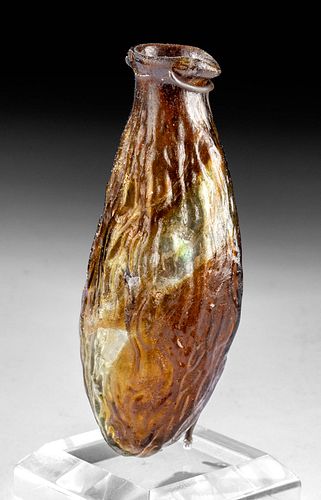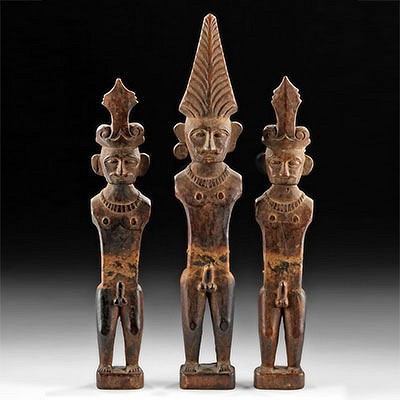Roman Sidonian Mold-Blown Glass Date Bottle
Lot 31
About Seller
Artemis Gallery
686 S Taylor Ave, Ste 106
Louisville, CO 80027
United States
Selling antiquities, ancient and ethnographic art online since 1993, Artemis Gallery specializes in Classical Antiquities (Egyptian, Greek, Roman, Near Eastern), Asian, Pre-Columbian, African / Tribal / Oceanographic art. Our extensive inventory includes pottery, stone, metal, wood, glass and textil...Read more
Categories
Estimate:
$1,200 - $1,800
Absentee vs Live bid
Two ways to bid:
- Leave a max absentee bid and the platform will bid on your behalf up to your maximum bid during the live auction.
- Bid live during the auction and your bids will be submitted real-time to the auctioneer.
Bid Increments
| Price | Bid Increment |
|---|---|
| $0 | $25 |
| $300 | $50 |
| $1,000 | $100 |
| $2,000 | $250 |
| $5,000 | $500 |
| $10,000 | $1,000 |
| $20,000 | $2,500 |
| $50,000 | $5,000 |
| $100,000 | $10,000 |
| $200,000 | $20,000 |
About Auction
By Artemis Gallery
Jun 25, 2020
Set Reminder
2020-06-25 10:00:00
2020-06-25 10:00:00
America/New_York
Bidsquare
Bidsquare : CLEARANCE - Ancient, Pre-Columbian, Ethno Art
https://www.bidsquare.com/auctions/artemis-gallery/clearance---ancient-pre-columbian-ethno-art-5264
Featuring discounted pricing on antiquities from Egypt, Greece, Italy, and the Near East...plus Viking, Asian, Pre-Columbian, Tribal, Russian Icons, Spanish Colonial, Fine Art, more! Starting prices have been reduced up to 65% from original auction prices - perfect for dealers and collectors. Artemis Gallery info@artemisgallery.com
Featuring discounted pricing on antiquities from Egypt, Greece, Italy, and the Near East...plus Viking, Asian, Pre-Columbian, Tribal, Russian Icons, Spanish Colonial, Fine Art, more! Starting prices have been reduced up to 65% from original auction prices - perfect for dealers and collectors. Artemis Gallery info@artemisgallery.com
- Lot Description
**Originally Listed At $700**
Roman Empire, Lebanon, Sidonian, ca. mid 1st to early 2nd century CE. A fine mold-blown flask resembling a date fruit in gorgeous translucent amber glass with bands of lemon yellow and hints of aubergine - the vessel's generally oblong form presenting a short neck and a flaring rim with an infolded lip. Note how the mold was meticulously rendered to create the impression of a date's wrinkled skin. In addition to its stunning coloring, areas of rainbow iridescence cast a glow upon the surface. Size: 3.25" H (8.3 cm); 3.8" H (9.7 cm) on included custom stand.
Here are Pliny's words as he describes his voyage to Sidon, "From this point on we must go back to the coast and to Phoenicia. There was formerly a town called Crocodilian, and there still is a river of that name … Then comes Cape Carmel … Next are Getta, Geba, and the river Pacida or Belus … Close to this river is Ptolemais … Next Tyre, once an island separated from the mainland by a very deep sea-channel 700 yards wide, but now joined to it by the works constructed by Alexander when besieging the place … but the entire renown of Tyre now consists in a shell-fish and a purple dye! … Next are Zarephath and the city of birds (Ornithon oppidum), and Sidon, the mother-city of Thebes in Boeotia where glass is made." (Pliny, Natural History V.75-76, 77-79 CE).
For an almost identical example, see lot 185, Sotheby's New York Antiquities Auction, 14 June 2000; for another similar example, lot # 74, the Constable Maxwell collection of ancient glass, Sotheby Parke Bernet auction, 4/5 June, 1979. Cf. no. V-57, Reflection on Ancient Glass from the Borowski Collection. Cf. Toledo, Roman Mold Blown Glass, nos. 84 - 107. The author notes that Phoenicia during the 1st century CE "was famous not only for mold blown glass but for its date palms," and this may have "inspired glass workers in Phoenicia to blow vessels shaped like dates."
Provenance: ex-Stephen Shalom, collection, New York City, New York, USA, 1970s, purchased in Israel
All items legal to buy/sell under U.S. Statute covering cultural patrimony Code 2600, CHAPTER 14, and are guaranteed to be as described or your money back.
A Certificate of Authenticity will accompany all winning bids.
We ship worldwide and handle all shipping in-house for your convenience.
#147865Chips to rim and side wall. A few stable hairline pressure fissures to the body, possibly indicative of repair but very difficult to discern. Internal bubbles in the glass and traces of weathering film.Condition
- Shipping Info
-
All shipping is handled in-house for your convenience. Your invoice from Artemis Gallery will include shipping calculation instructions. If in doubt, please inquire BEFORE bidding for estimated shipping costs for individual items.
-
- Buyer's Premium



 EUR
EUR CAD
CAD AUD
AUD GBP
GBP MXN
MXN HKD
HKD CNY
CNY MYR
MYR SEK
SEK SGD
SGD CHF
CHF THB
THB












